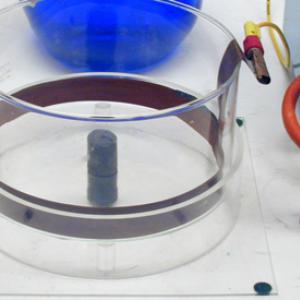College of Liberal Arts & Sciences
5H30.50 - Magnetohydrodynamic Motor - Ion Motor
The MHD motor is designed to run on the overhead projector. Hook the power supply to the electrodes as shown. Remember that there is a magnet that the center electrode fits over. Fill the dish with sat'd copper sulfate sol'n until it is even with the top of the outer electrode. Turn on the power and watch the liquid rotate about the center electrode. Reverse the power supply leads and the liquid will rotate in the opposite direction. Sprinkle some Lycopodium powder on the top of the copper sulfate to make the rotation highly visible.
- James Lincoln and Nick Moore, "Five Fresh Lorentz Force Demos", TPT, Vol. 57, #8, Nov. 2019, p. 572.
- James Overduin, Viktor Polyak, Anjalee Rutah, Thomas Sebastian, Jim Selway, and Daniel Zile, "The Hunt for Red October II: A Magnetohydrodynamic Boat Demonstration for Introductory Physics", TPT, Vol. 55, #8, Nov. 2017, p. 460.
- Marián Kireš and Zuzana Ješková, "Magnetic Force in an Electrolyte", TPT, Vol. 45, #1, Jan. 2007, p. 50.
- "Correction: 'Magnetohydrodynamic Propulsion for the Classroom' [Phys. Teach. 42, 410–415 (Oct. 2004)]", TPT, Vol. 42, #9, Dec. 2004, p. 517.
- Gabriel I. Font and Scott C. Dudley, "Magnetohydrodynamic Propulsion for the Classroom", TPT, Vol. 42, #7, Oct. 2004, p. 410.
- Willem H. van den Berg and Kirk A. Miller, "Moving Water With No Moving Parts", TPT, Vol. 35, #9, Dec. 1997, p. 531.
- Earl Zwicker, "Doing Physics: The Right-Hand Rule Made Visible?", TPT, Vol. 27, #9, Dec. 1989, p. 684.
- Esi Morgan, "Magnetohydrodynamics on a Tabletop", TPT, Vol. 25, #5, May 1987, p. 325.
- Arthur Kantrowitz and Richard J. Rosa, "MHD Power Generation", TPT, Vol.13, #8, Nov. 1975, p. 455.
- Rafael M. Digilov, "Making a Fluid Rotate: Circular Flow of a Weakly Conducting Fluid Induced by a Lorentz Body Force", AJP, Vol. 75, #4, Apr. 2007, p. 361.
- Stanislaw Bednarek, "Self-Powered Magnetohydrodynamic Motors", AJP, Vol. 64, #1, Jan. 1996, p. 90.
- J. P. Rayner, "Experiments in Magnetohydrodynamics", AJP, Vol. 38, #6, June 1970, p. 736.
- E. W. LeMaster and L. C. Shepley, "A Simple MHD Pump", AJP, Vol. 38, #3, Mar. 1970, p. 389.
- James E. Martin and Kyle J. Solis, "Mesmerizing Magnetic Fields", Physics Today, Vol. 68, #8, Aug. 2015, p. 66.
- Hantao Ji and Steven Balbus, "Angular Momentum Transport in Astrophysics and the Lab", Physics Today, Vol. 66, #8, Aug. 2013, p. 27.
- Richard E. Berg, "A Magnetohydrodynamic Generator", PIRA Newsletter, Vol. 3, #17, Jan. 1990, p. 6.
- G. D. Freier and F. J. Anderson, "Ei-13", A Demonstration Handbook for Physics.
- "MHD II: Make a Magnetohydrodynamic Propulsion Boat", https://www.evilmadscientist.com/2006/mhd-ii-make-a-magnetohydrodynamic-..., Aug. 31, 2010.
- "MHD I: Demonstrate Magnetohydrodynamic Propulsion in a Minute", https://www.evilmadscientist.com/2006/mhd-i-demonstrate-magnetohydrodyna..., Aug. 31, 2010.
Disclaimer: These demonstrations are provided only for illustrative use by persons affiliated with The University of Iowa and only under the direction of a trained instructor or physicist. The University of Iowa is not responsible for demonstrations performed by those using their own equipment or who choose to use this reference material for their own purpose. The demonstrations included here are within the public domain and can be found in materials contained in libraries, bookstores, and through electronic sources. Performing all or any portion of any of these demonstrations, with or without revisions not depicted here entails inherent risks. These risks include, without limitation, bodily injury (and possibly death), including risks to health that may be temporary or permanent and that may exacerbate a pre-existing medical condition; and property loss or damage. Anyone performing any part of these demonstrations, even with revisions, knowingly and voluntarily assumes all risks associated with them.

